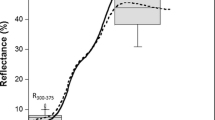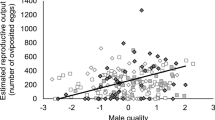Abstract
Female mate choice has been shown to provide direct mating benefits in several animal groups. In butterflies, for which there are increasing reports of fine-scale color-based mate choice, the evolutionary benefits that accrue from such mating biases, if any, are largely unknown. We addressed this issue in the butterfly Colias eurytheme, a species in which females choose mates on the basis of iridescent ultraviolet (UV) wing ornamentation and in which males donate reproductively beneficial nuptial gifts. In the first experiment, we assessed the mass of gifts donated to 77 virgin females by males sampled directly from a field encounter site. Despite large variance in the male adult phenotype and ejaculate, no single aspect of dorsal wing coloration, including UV brightness, chroma, or hue, was related to ejaculate mass. There was, however, an interesting interaction between the effects of male body size and copula duration upon ejaculate mass, with size scaling positively with ejaculate mass among males involved in shorter copulations (those lasting <70 min) but negatively among males in longer copulations. In the second experiment, we assessed the lifetime fecundity, fertility, and longevity of 85 females mated under similar circumstances to free-flying wild males. Although several wing color parameters proved subtly informative in more sophisticated multivariable models, no model predicted more than about 20% of the variation in any single female fitness parameter. The duration of copulation, which ranged from 35 min to over 16 h and which carries putative costs for females, was, again, only very weakly predicted by male wing color parameters (i.e., R 2 = 0.089). Given the overall minor predictive power of male wing coloration in general and of UV brightness in particular, our results do not strongly support the hypothesis that female C. eurytheme prefer bright UV males to obtain direct benefits or to minimize the costs associated with lengthy copulations.



Similar content being viewed by others
References
Andersson MB (1994) Sexual Selection. Princeton University Press, Princeton, NJ
Andersson M, Simmons LW (2006) Sexual selection and mate choice. Trends Ecol Evol 21:296–302
Boggs CL (1995) Male nuptial gifts: Phenotypic consequences and evolutionary implications. In: Leather SR, Hardie J (eds) Insect reproduction. CRC Press, New York, pp 215–242
Boggs CL, Gilbert LE (1979) Male contribution to egg production in butterflies—evidence for transfer of nutrients at mating. Science 206:83–84
Boggs CL, Watt WB (1981) Population structure of pierid butterflies IV. Genetic and physiological investment in offspring by male Colias. Oecologia 50:320–324
Bonduriansky R, Wheeler J, Rowe L (2005) Ejaculate feeding and female fitness in the sexually dimorphic fly Prochyliza xanthostoma (Diptera: Piophilidae). Anim Behav 69:489–497
Burnham KP, Anderson DR (2002) Model selection and multimodel inference: a practical information-theoretic approach. Springer, New York
Bussière LF, Abdul Basit H, Gwynne DT (2005) Preferred males are not always good providers: female choice and male investment in tree crickets. Behav Ecol 16:223–231
Cook PA, Wedell N (1996) Ejaculate dynamics in butterflies: a strategy for maximizing fertilization success? Proc R Soc Lond (B) 263:1047–1051
Costanzo K, Monteiro A (2007) The use of chemical and visual cues in female choice in the butterfly Bicyclus anynana. Proc R Soc Lond (B) 274:845–851
Czesak ME, Fox CW (2003) Genetic variation in male effects on female reproduction and the genetic covariance between the sexes. Evolution 57:1359–1366
Eberhard WG (1996) Female Control: Sexual Selection by Cryptic Female Choice. Princeton University Press, Princeton, NJ
Fedorka KM, Mousseau TA (2002) Nuptial gifts and the evolution of male body size. Evolution 56:590–596
Fox CW, McLennan LA, Mousseau TA (1995a) Male body size affects female lifetime reproductive success in a seed beetle. Anim Behav 50:281–284
Fox CW, Hickman DL, Raleigh EL, Mousseau TA (1995b) Paternal investment in a seed beetle (Coleoptera: Bruchidae): influence of male size, age, and mating history. Ann Entomol Soc Am 88:101–103
Ghiradella H (1974) Development of ultraviolet-reflecting butterfly scales: how to make an interference filter. J Morphol 142:395–410
Gwynne DT (1984) Courtship feeding increases female reproductive success in bushcrickets. Nature 307:361–363
Hughes L, Chang BSW, Wagner D, Pierce NE (2000) Effects of mating history on ejaculate size, fecundity, longevity, and copulation duration in the ant-tended lycaenid butterfly, Jalmenus evagoras. Behav Ecol Sociobiol 47:119–128
Hunt J, Brooks R, Jennions MD (2005) Female mate choice as a condition-dependent life-history trait. Am Nat 166:79–92
Iyengar VK, Eisner T (1999) Female choice increases offspring fitness in an arctiid moth (Utetheisa ornatrix). Proc Natl Acad Sci U S A 96:15013–15016
Jones TM, Quinnell RJ, Balmford A (1998) Fisherian flies: benefits of female choice in a lekking sandfly. Proc R Soc Lond (B) 265:1651–1657
Karlsson B (1998) Nuptial gifts, resource budgets, and reproductive output in a polyandrous butterfly. Ecology 79:2931–2940
Kemp DJ (2006) Heightened phenotypic variation and age-based fading of ultraviolet butterfly wing coloration. Evol Ecol Res 8:515–527
Kemp DJ (2007) Female butterflies prefer males bearing bright iridescent ornamentation. Proc R Soc Lond (B) 274:1043–1047
Kemp DJ, Rutowski RL (2007) Condition dependence, quantitative genetics, and the potential signal content of iridescent ultraviolet butterfly coloration. Evolution 61:168–183
Kirkpatrick M (1996) Good genes and direct selection in the evolution of mating preferences. Evolution 50:2125–2140
Lauwers K, Van Dyck H (2006) The cost of mating with a non-virgin male in a monandrous butterfly: experimental evidence from the speckled wood, Pararge aegeria. Behav Ecol Sociobiol 60:69–76
Leimar O, Karlsson B, Wiklund C (1994) Unpredictable food and sexual size dimorphism in insects. Proc R Soc Lond (B) 258:121–125
Linville SU, Breitwisch R, Schilling AJ (1998) Plumage brightness as an indicator of parental care in northern cardinals. Anim Behav 55:119–127
Oberhauser KS (1997) Fecundity, lifespan and egg mass in butterflies: effects of male-derived nutrients and female size. Funct Ecol 11:166–175
Papke RS, Kemp DJ, Rutowski RL (2007) Multimodal signalling: structural ultraviolet reflectance predicts male mating success better than pheromones in the butterfly Colias eurytheme L. (Pieridae). Anim Behav 73:47–54
Post CT, Goldsmith TH (1969) Physiological evidence for color receptors in the eye of a butterfly. Ann Entomol Soc Am 62:1497–1498
Préault M, Chastel O, Cézilly F, Faivre B (2005) Male bill colour and age are associated with parental abilities and breeding performance in blackbirds. Behav Ecol Sociobiol 58:497–505
Rutowski RL (1985) Evidence for mate choice in a sulphur butterfly (Colias eurytheme). Z Tierpsychol 70:103–114
Rutowski RL, Gilchrist GW (1986) Copulation in Colias eurytheme (Lepidoptera: Pieridae): patterns and frequency. J Zool 209:115–124
Rutowski RL, Gilchrist GW, Terkanian B (1987) Female butterflies mated with recently mated males show reduced reproductive output. Behav Ecol Sociobiol 20:319–322
Senar JC, Figuerola J, Pascual J (2002) Brighter yellow blue tits make better parents. Proc R Soc Lond (B) 269:257–261
Silberglied RE, Taylor OR (1978) Ultraviolet reflection and its behavioral role in the courtship of the sulphur butterflies Colias eurytheme and C. philodice (Lepidoptera, Pieridae). Behav Ecol Sociobiol 3:203–243
Tallamy DW, Burton Darlington M, Pesek JD, Powell BE (2003) Copulatory courtship signals male genetic quality in cucumber beetles. Proc R Soc Lond (B) 270:77–82
Talloen W, Van Dyck H, Lens L (2004) The cost of melanization: butterfly wing coloration under environmental stress. Evolution 58:360–366
Thornhill R (1976) Sexual selection and nuptial feeding behavior in Bittacus apicalis (Insecta: Mecoptera). Am Nat 110:529–548
Torres-Vila LM, Jennions MD (2005) Male mating history and female fecundity in the Lepidoptera: do male virgins make better partners? Behav Ecol Sociobiol 57:318–326
Vahed K (1998) The function of nuptial feeding in insects: a review of empirical studies. Biol Rev 73:43–78
Velando A, Torres R, Espinosa I (2005) Male coloration and chick condition in blue-footed booby: a cross-fostering experiment. Behav Ecol Sociobiol 58:175–180
Wagner WE, Harper CJ (2003) Female life span and fertility are increased by the ejaculates of preferred males. Evolution 57:2054–2066
Watt WB (1964) Pteridine components of wing pigmentation in the butterfly Colias eurytheme. Nature 201:1326–1327
Wedell N (1996) Mate quality affects reproductive effort in a paternally investing species. Am Nat 148:1075–1088
Wedell N (2006) Male genotype affects female fitness in a paternally investing species. Evolution 60:1638–1645
Wing SR (1988) Cost of mating for female insects: risk of predation in Photinus collustrans (Coleoptera, Lampyridae). Am Nat 131:139–142
Zahavi A (1975) Mate selection—a selection for a handicap. J Theor Biol 53:205–214
Acknowledgment
This research was jointly supported by the Australian Research Council grant no. DP0557190 (to D.J.K.) and the National Science Federation grant no. 0316120 (to R.L.R.).
Author information
Authors and Affiliations
Corresponding author
Additional information
Communicated by N. Wedell
Rights and permissions
About this article
Cite this article
Kemp, D.J., Macedonia, J.M., Ball, T.S. et al. Potential direct fitness consequences of ornament-based mate choice in a butterfly. Behav Ecol Sociobiol 62, 1017–1026 (2008). https://doi.org/10.1007/s00265-007-0529-5
Received:
Revised:
Accepted:
Published:
Issue Date:
DOI: https://doi.org/10.1007/s00265-007-0529-5




